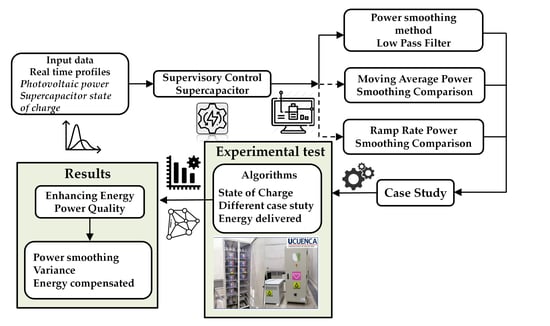Enhancing Energy Power Quality in Low-Voltage Networks Integrating Renewable Energy Generation: A Case Study in a Microgrid Laboratory
Abstract
:1. Introduction
2. Materials and Methods
2.1. Description of the SC-ESS of the Micro-Grid Laboratory
2.2. Design of Power Smoothing Algorithm Based on a Low-Pass Filter
- -
- First, the inputs variables are collected from the microgrid (, , α, ), then auxiliary variables are assigned (aux,i). Both SC-ESS overcharged and over-discharged produce severe effects on the lifespan.
- -
- Then, in order to avoid these issues, the SoC of SC needs to be limited. If during the smoothing actions provided by the SC-ESS its SoC approaches its lower threshold, the proposed method will prioritize the SC-ESS load until the SoC is raised to a safe level to continue the control tasks. Analogous reasoning explains what would happen if the SoC reaches its upper limit. This feature is achieved by a supervisory control of the energy storage, which generates the value of the limit constant k shown in the diagram in Figure 3. Further details of this supervisory control are presented in Section 2.4. The constraints of SC-ESS depend on α. Therefore, if the SoC of SC-ESS is lower than the minimum SoC (), the energy generation of PV charges the SC-ESS until reaching the upper limit, as show in Figure 3. Is important to mention that all variables are stored separately for further analysis.

2.3. Design of Power Smoothing Algorithm Based on MA
- -
- First, the input variables are defined , and similarly to the previous case, the input variables are assigned their auxiliary variables .
- -
- Then, the individual extreme values of each target function corresponding to the minimum and maximum state of charge in SC are found, where is defined by the number of samples in time windows by the power smoothing. The calculations are performed by obtaining the output value that can be seen in the system.
- -
- Finally, as in the previous case, the SoC of the SC-ESS is maintained at safe levels thanks to the implementation of a supervisory control of energy storage described in the following subsection.

2.4. Design of Power Smoothing Algorithm Based on RR Method
- -
- First, the input variables (, , sp, ) are defined similarly to the previous case, and their auxiliary variables (roc,i) are assigned—the percentage value of the ramp rate (0 < rr <1) is also assigned.
- -
- The rate of power change (roc) is calculated as the difference between the current power (i) and the previous power sp(i).
- -
- The initial rate of power change is stored in roc(i) before applying any limitations.
- -
- If the rate of power change exceeds the ramp limit (rr), it is adjusted by limiting it to the established limit while maintaining its original di-rection (positive or negative) using the sign function [28].
- -
- The smoothed power sp for the current sample is calculated by adding the limited rate of power change to the previous smoothed power. This ensures that the smoothed power changes gradually and stays within the ramp limits. A variable change is then made to store the com-pensated power ((i) = sp(i)), followed by the calculation of .
- -
- Finally, as in the previous case, the SoC of the SC-ESS is ensured to be maintained at safe levels though the implementation of an energy storage supervision control.
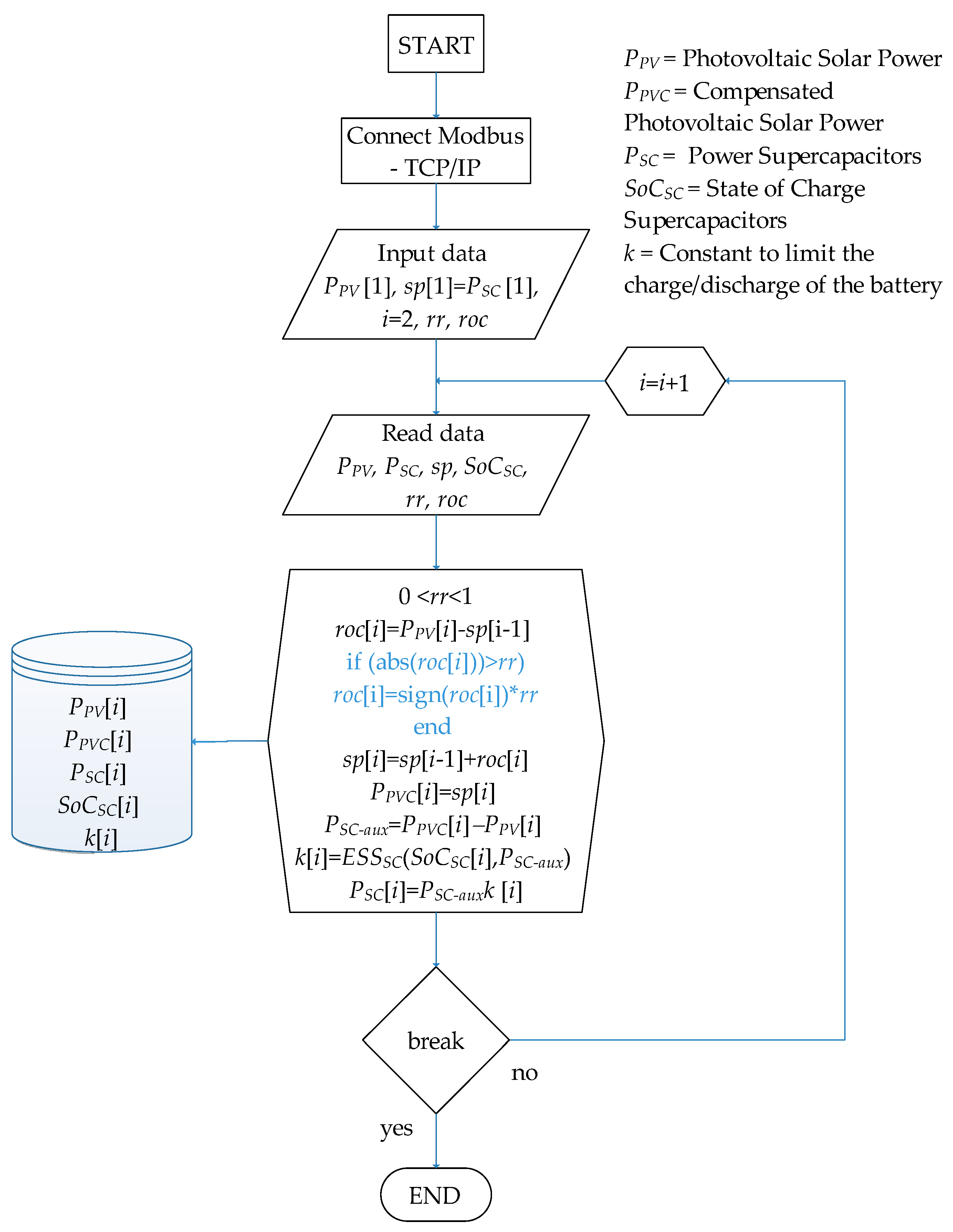
2.5. Supervisory Control of SC-ESS
- -
- When the SOCSC < 80%, the SC-ESS absorbs a power limited by the constant (k = 0.1); however, the SC-ESS is able to deliver its maximum power capacity if k = 1.
- -
- If 20% < SOCSC < 80%, the SC-ESS operates normally, delivering or absorbing the full power with k = 1.
- -
- If the percentage of charge of the SC falls below 20%, the storage system is considered to be in a low range, and priority is given to its charging to maintain its operation. For power values of the SC () greater than zero, a minimum value is assigned to the constant “k” in order to minimize the discharge of the SC (k = 0.1). For power values lower than zero (), a maximum value of the constant “k” equal to 1 is assigned to ensure its charging and achieve normal operating values (see Figure 6). These conditions within the algorithms ensure that the SC remains within its safe operating range, thereby preserving its SoC and extending its lifespan.
| Condition | |||
|---|---|---|---|
| - | |||
3. Case of Study
3.1. Implementation of the Power Smoothing System in the Experimental Platform (CCTI-B)
3.2. Types of Daily PV Power Curves
4. Result and Discussions
- Case 1: SC-ESS at the maximum SoC (overcharged condition)Under these circumstances, it is mandated that the SC-ESS be charged to a level exceeding 80% of its SoC prior to performing the power smoothing tasks.
- Case 2: SC-ESS in a medium SoCIn this scenario, a requirement is established for the SoC of the SC-ESS to be maintained within the range of 20% to 80% as an initial condition.
- Case 3: SC-ESS at the minimum SoC (undercharged condition)Lastly, for this specific undercharged state, the SC-ESS starts its compensation work with a value below 20% of its maximum storage capacity.
4.1. Low Pass Filter Based Power Smoothing Method Results
4.2. Moving-Average-Based Power Smoothing Method Results
4.3. Ramp Rate Filter Based Power Smoothing Method Results
4.4. Comparison between Methods
5. Conclusions
- The LP and RR filters achieve a variance reduction of 11.4% and 10%, respectively, for initial SoC percentages above 80%, demonstrating superior power smoothing. Meanwhile, the MA filter reduces variance by 4.4% for the same initial SoC percentages, delivering more stable energy output.
- By comparing the results provided in Table 2, Table 3 and Table 4, it can be seen that each method studied offers advantages and disadvantages depending on the parameters analyzed. LP and RR offer the best smoothing effectiveness. However, this performance penalizes the energy delivered to the grid. The MA method offers an acceptable level of smoothing, while sacrificing less PV energy to make it available to the grid.
- The LP and RR filter excels in power smoothing, adapting energy delivery based on the SoC percentage. Conversely, the MA filter capitalizes on the SC-ESS’s higher energy storage capacity, increasing energy delivery.
- These findings highlight the trade-off between power smoothing and energy delivery. The LP and RR filters achieve superior power smoothing, while the MA filter offers slightly higher energy delivery capabilities. Choosing between the methods depends on specific system requirements and priorities regarding power stability and energy availability.
Author Contributions
Funding
Data Availability Statement
Acknowledgments
Conflicts of Interest
Appendix A. Supercapacitor-Based Energy Storage System (SC-ESS) Installed in the Micro-Grid Laboratory of the Universidad de Cuenca
| Electrical Parameters | Value and Units | Power and Energy (Array) |
|---|---|---|
| Rated Capacitance | 130 F | - |
| Maximum ESR DC, initial | 8.1 mΩ | - |
| Rated Voltage | 56 V | - |
| Absolute Maximum Voltage | 62 V | - |
| Maximum Peak Current, 1 s | 1800 A | - |
| Standby Current, maximum (Passive Balancing) | 120 mA | - |
| Maximum Series Voltage | 750 V | - |
| Mass, typical | 18 kg | - |
| Volume (0.683 × 0.177 × 0.175) | 0.021156 m3 | - |
| Density | 850.83 kg/m3 | - |
| Usable Specific Power, Pd | - | 28,600 W/kg |
| Impedance Match Specific Power, Pmax | - | 59,400 W/kg |
| Specific Energy, Emax | - | 34.1 Wh/kg |
| Stored Energy | - | 622.6 Wh |
| DC Input | AC Output | Efficiency | |
|---|---|---|---|
| SoC voltage range (max. power) | 425–800 VDC | - | - |
| Max. input voltage | 900 VDC | - | - |
| Max. input current | 75 A | - | - |
| Nominal AC voltage | - | 3 × 400 VAC | - |
| Frequency | - | 50/60 Hz | - |
| Rated AC power @25 oC | - | 30 kW | - |
| Maximum output current | - | 52 A | - |
| Total Harmonic Distortion (THD) | - | <3% | - |
| Power Factor | - | Dynamically adjustable (PQ mode) | - |
| Maximum efficiency | - | - | 96% |
| Self-consumption standby | - | - | ≤50 W |
References
- Anghelache, C.; Anghel, M.G.; Iacob, Ș.V.; Pârțachi, I.; Rădulescu, I.G.; Brezoi, A.G. Analysis of the Situation of Renewable and Non-Renewable Energy Consumption in the European Union. Energies 2023, 16, 1338. [Google Scholar] [CrossRef]
- Augusto Pereira, H.; Fagner Cupertino, A.; Wu, J.-C.; Jou, H.-L.; Chang, C.-H. Power Conversion Interface for a Small-Capacity Photovoltaic Power Generation System. Energies 2023, 16, 1097. [Google Scholar] [CrossRef]
- Fregosi, D.; Pilot, N.; Bolen, M.; Hobbs, W.B. An Analysis of Storage Requirements and Benefits of Short-Term Forecasting for PV Ramp Rate Mitigation. IEEE J. Photovolt. 2023, 13, 315–324. [Google Scholar] [CrossRef]
- Xu, J.; Xie, B.; Liao, S.; Ke, D.; Sun, Y.; Jiang, X.; Yu, J. CVR-Based Real-Time Power Fluctuation Smoothing Control for Distribution Systems with High Penetration of PV and Experimental Demonstration. IEEE Trans. Smart Grid 2022, 13, 3619–3635. [Google Scholar] [CrossRef]
- Cano, A.; Arévalo, P.; Benavides, D.; Jurado, F. Comparative Analysis of HESS (Battery/Supercapacitor) for Power Smoothing of PV/HKT, Simulation and Experimental Analysis. J. Power Sources 2022, 549, 232137. [Google Scholar] [CrossRef]
- Wu, T.; Yu, W.; Guo, L. A Study on Use of Hybrid Energy Storage System along with Variable Filter Time Constant to Smooth DC Power Fluctuation in Microgrid. IEEE Access 2019, 7, 175377–175385. [Google Scholar] [CrossRef]
- Arévalo, P.; Benavides, D.; Tostado-Véliz, M.; Aguado, J.A.; Jurado, F. Smart Monitoring Method for Photovoltaic Systems and Failure Control Based on Power Smoothing Techniques. Renew. Energy 2023, 205, 366–383. [Google Scholar] [CrossRef]
- Benavides, D.; Arévalo, P.; Tostado-Véliz, M.; Vera, D.; Escamez, A.; Aguado, J.A.; Jurado, F. An Experimental Study of Power Smoothing Methods to Reduce Renewable Sources Fluctuations Using Supercapacitors and Lithium-Ion Batteries. Batteries 2022, 8, 228. [Google Scholar] [CrossRef]
- Benavides, D.; Arévalo, P.; Aguado, J.A.; Jurado, F. Experimental Validation of a Novel Power Smoothing Method for On-Grid Photovoltaic Systems Using Supercapacitors. Int. J. Electr. Power Energy Syst. 2023, 149, 109050. [Google Scholar] [CrossRef]
- Ma, W.; Wang, W.; Wu, X.; Hu, R.; Tang, F.; Zhang, W.; Han, X.; Ding, L. Optimal Allocation of Hybrid Energy Storage Systems for Smoothing Photovoltaic Power Fluctuations Considering the Active Power Curtailment of Photovoltaic. IEEE Access 2019, 7, 74787–74799. [Google Scholar] [CrossRef]
- Nempu, P.B.; Sabhahit, J.N.; Gaonkar, D.N.; Rao, V.S. Novel Power Smoothing Technique for a Hybrid AC-DC Microgrid Operating with Multiple Alternative Energy Sources. Adv. Electr. Comput. Eng. 2021, 21, 99–106. [Google Scholar] [CrossRef]
- Ma, W.; Wang, W.; Wu, X.; Hu, R.; Tang, F.; Zhang, W. Control Strategy of a Hybrid Energy Storage System to Smooth Photovoltaic Power Fluctuations Considering Photovoltaic Output Power Curtailment. Sustainability 2019, 11, 1324. [Google Scholar] [CrossRef] [Green Version]
- Krishan, O.; Suhag, S. A Novel Control Strategy for a Hybrid Energy Storage System in a Grid-Independent Hybrid Renewable Energy System. Int. Trans. Electr. Energy Syst. 2020, 30, e12262. [Google Scholar] [CrossRef]
- Saripalli, B.P.; Singh, G.; Singh, S. Supercapacitors Based Energy Storage System for Mitigating Solar Photovoltaic Output Power Fluctuations. World J. Eng. 2022. [Google Scholar] [CrossRef]
- Chong, L.W.; Wong, Y.W.; Rajkumar, R.K.; Isa, D. An Optimal Control Strategy for Standalone PV System with Battery-Supercapacitor Hybrid Energy Storage System. J. Power Sources 2016, 331, 553–565. [Google Scholar] [CrossRef]
- Kanehira, T.; Takahashi, A.; Imai, J.; Funabiki, S. A Comparison of Electric Power Smoothing Control Methods for Distributed Generation Systems. Electr. Eng. Jpn. (Engl. Transl. Denki Gakkai Ronbunshi) 2015, 193, 49–57. [Google Scholar] [CrossRef]
- Takahashi, A.; Kajitani, T.; Funabiki, S. Parameter Determination for Reducing ESS Capacity in PV Power Smoothing Control Using Spline Function. Electr. Eng. Jpn. (Engl. Transl. Denki Gakkai Ronbunshi) 2022, 215, e23367. [Google Scholar] [CrossRef]
- Sukumar, S.; Marsadek, M.; Agileswari, K.R.; Mokhlis, H. Ramp-Rate Control Smoothing Methods to Control Output Power Fluctuations from Solar Photovoltaic (PV) Sources—A Review. J. Energy Storage 2018, 20, 218–229. [Google Scholar] [CrossRef]
- Ali, A.; Raisz, D.; Mahmoud, K. Voltage Fluctuation Smoothing in Distribution Systems with RES Considering Degradation and Charging Plan of EV Batteries. Electr. Power Syst. Res. 2019, 176, 105933. [Google Scholar] [CrossRef]
- Al Shereiqi, A.; Al-Hinai, A.; Albadi, M.; Al-Abri, R. Optimal Sizing of a Hybrid Wind-Photovoltaic-Battery Plant to Mitigate Output Fluctuations in a Grid-Connected System. Energies 2020, 13, 3015. [Google Scholar] [CrossRef]
- Aryani, D.R.; Kim, J.S.; Song, H. Suppression of Pv Output Fluctuation Using a Battery Energy Storage System with Model Predictive Control. Int. J. Fuzzy Log. Intell. Syst. 2017, 17, 202–209. [Google Scholar] [CrossRef] [Green Version]
- Malamaki, K.N.D.; Casado-Machado, F.; Barragan-Villarejo, M.; Gross, A.M.; Kryonidis, G.C.; Martinez-Ramos, J.L.; Demoulias, C.S. Ramp-Rate Limitation Control of Distributed Renewable Energy Sources via Supercapacitors. IEEE Trans. Ind. Appl. 2022, 58, 7581–7594. [Google Scholar] [CrossRef]
- D’Amico, G.; Petroni, F.; Vergine, S. Ramp Rate Limitation of Wind Power: An Overview. Energies 2022, 15, 5850. [Google Scholar] [CrossRef]
- Atif, A.; Khalid, M. Fuzzy Logic Controller for Solar Power Smoothing Based on Controlled Battery Energy Storage and Varying Low Pass Filter. IET Renew. Power Gener. 2020, 14, 3824–3833. [Google Scholar] [CrossRef]
- Atif, A.; Khalid, M. Saviztky-Golay Filtering for Solar Power Smoothing and Ramp Rate Reduction Based on Controlled Battery Energy Storage. IEEE Access 2020, 8, 33806–33817. [Google Scholar] [CrossRef]
- Pontes, L.; Costa, T.; Souza, A.; Dantas, N.; Vasconcelos, A.; Rissi, G.; Dias, R.; Mohamed, M.A.; Siano, P.; Marinho, M. Operational Data Analysis of a Battery Energy Storage System to Support Wind Energy Generation. Energies 2023, 16, 1468. [Google Scholar] [CrossRef]
- Ochoa, D.; Martinez, S.; Arévalo, P. A Novel Fuzzy-Logic-Based Control Strategy for Power Smoothing in High-Wind Penetrated Power Systems and Its Validation in a Microgrid Lab. Electronics 2023, 12, 1721. [Google Scholar] [CrossRef]
- Kumar, D.S.; Maharjan, S.; Albert; Srinivasan, D. Ramp-Rate Limiting Strategies to Alleviate the Impact of PV Power Ramping on Voltage Fluctuations Using Energy Storage Systems. Solar Energy 2022, 234, 377–386. [Google Scholar] [CrossRef]
- Espinoza, J.L.; Gonzalez, L.G.; Sempertegui, R. Micro Grid Laboratory as a Tool for Research on Non-Conventional Energy Sources in Ecuador. In Proceedings of the 2017 IEEE International Autumn Meeting on Power, Electronics and Computing, ROPEC, Ixtapa, Mexico, 8–10 November 2017; pp. 1–7. [Google Scholar] [CrossRef]
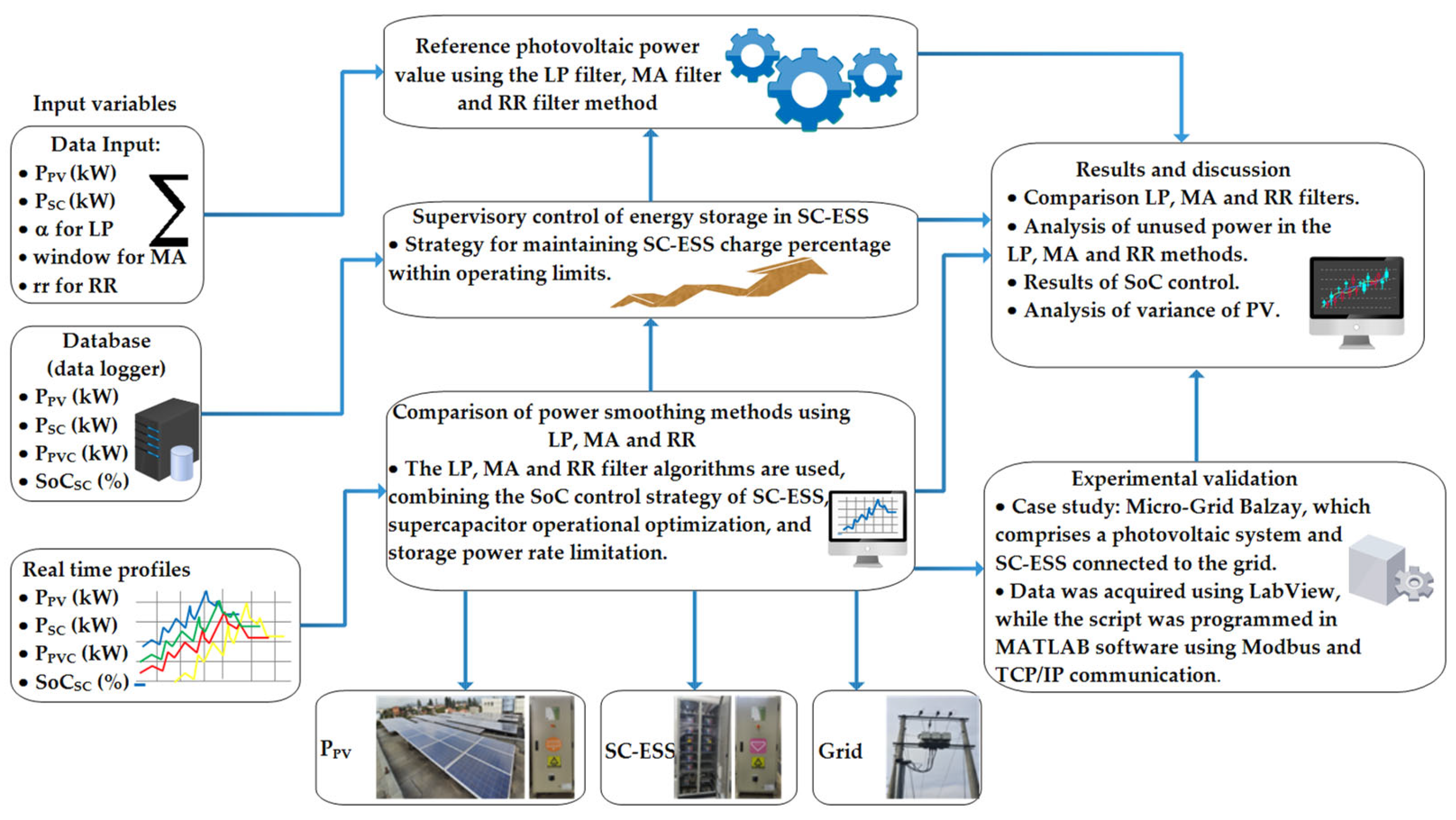

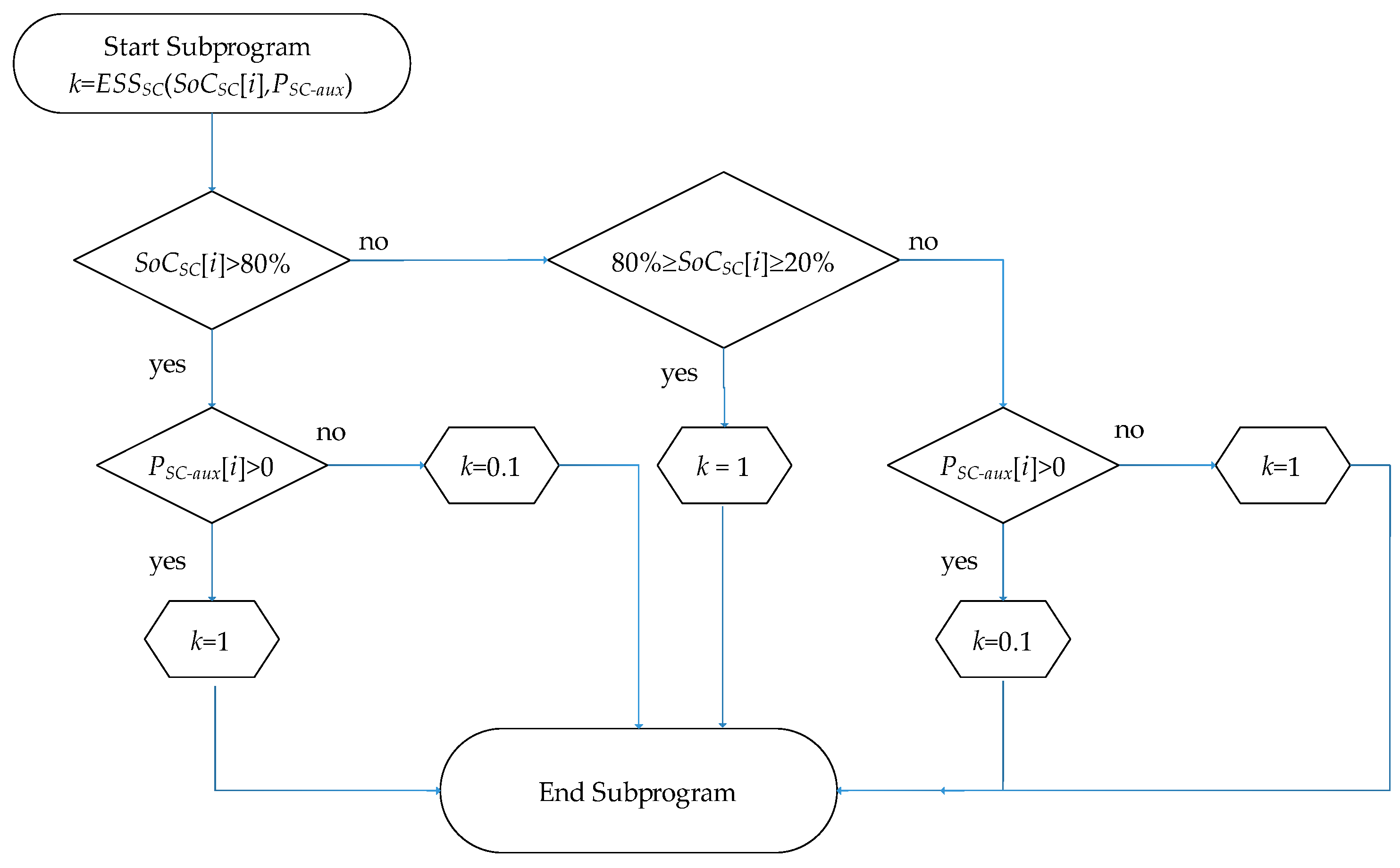
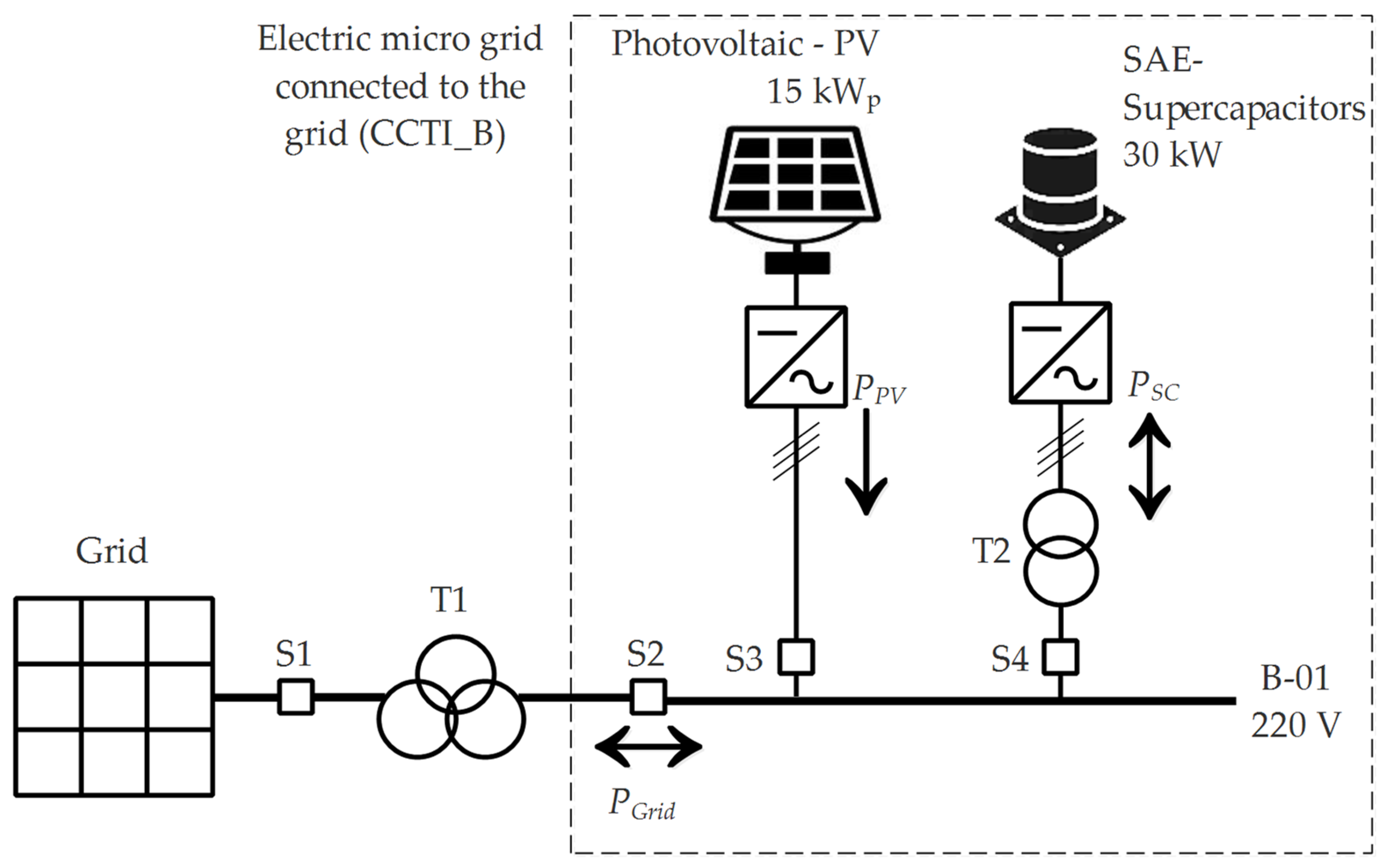
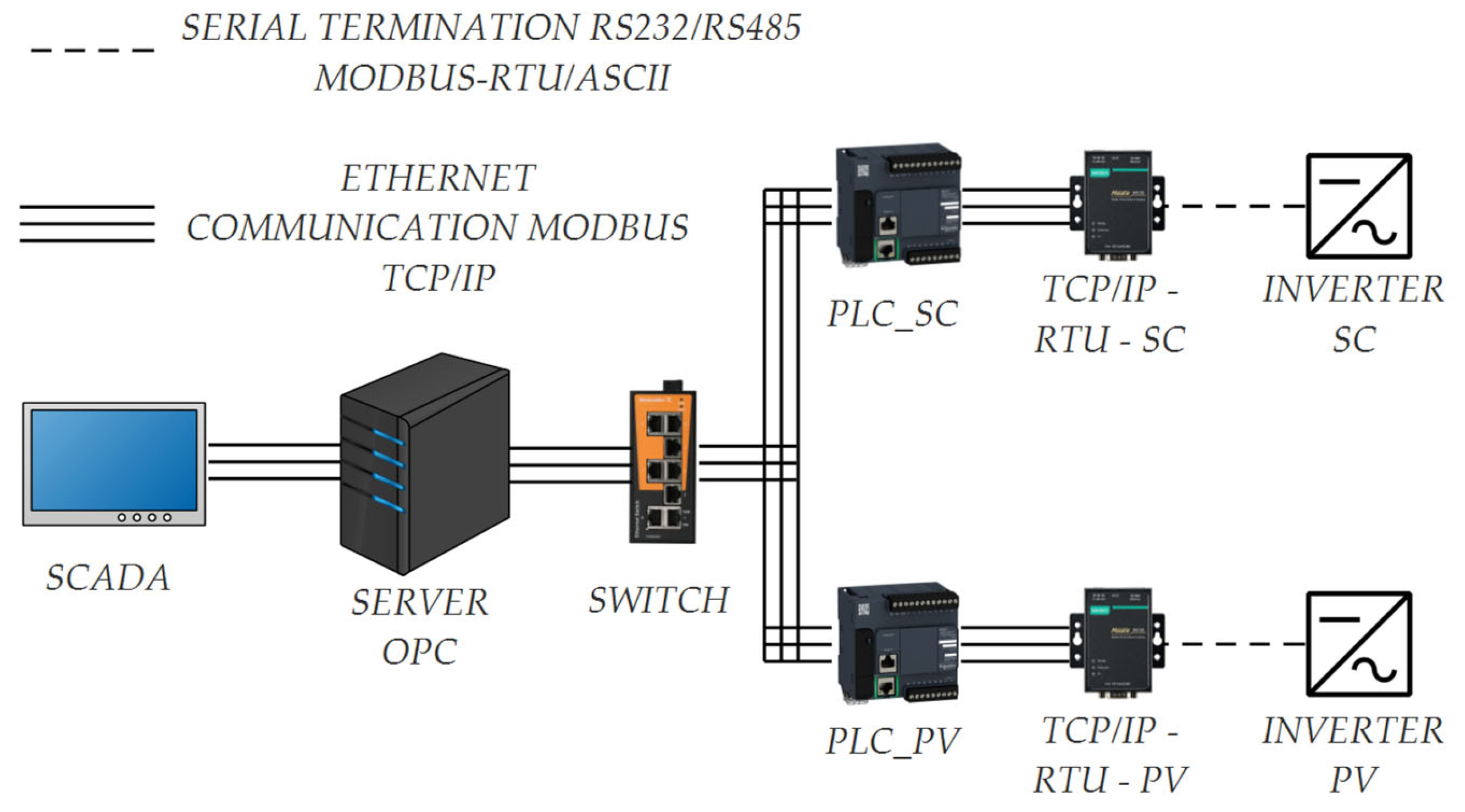



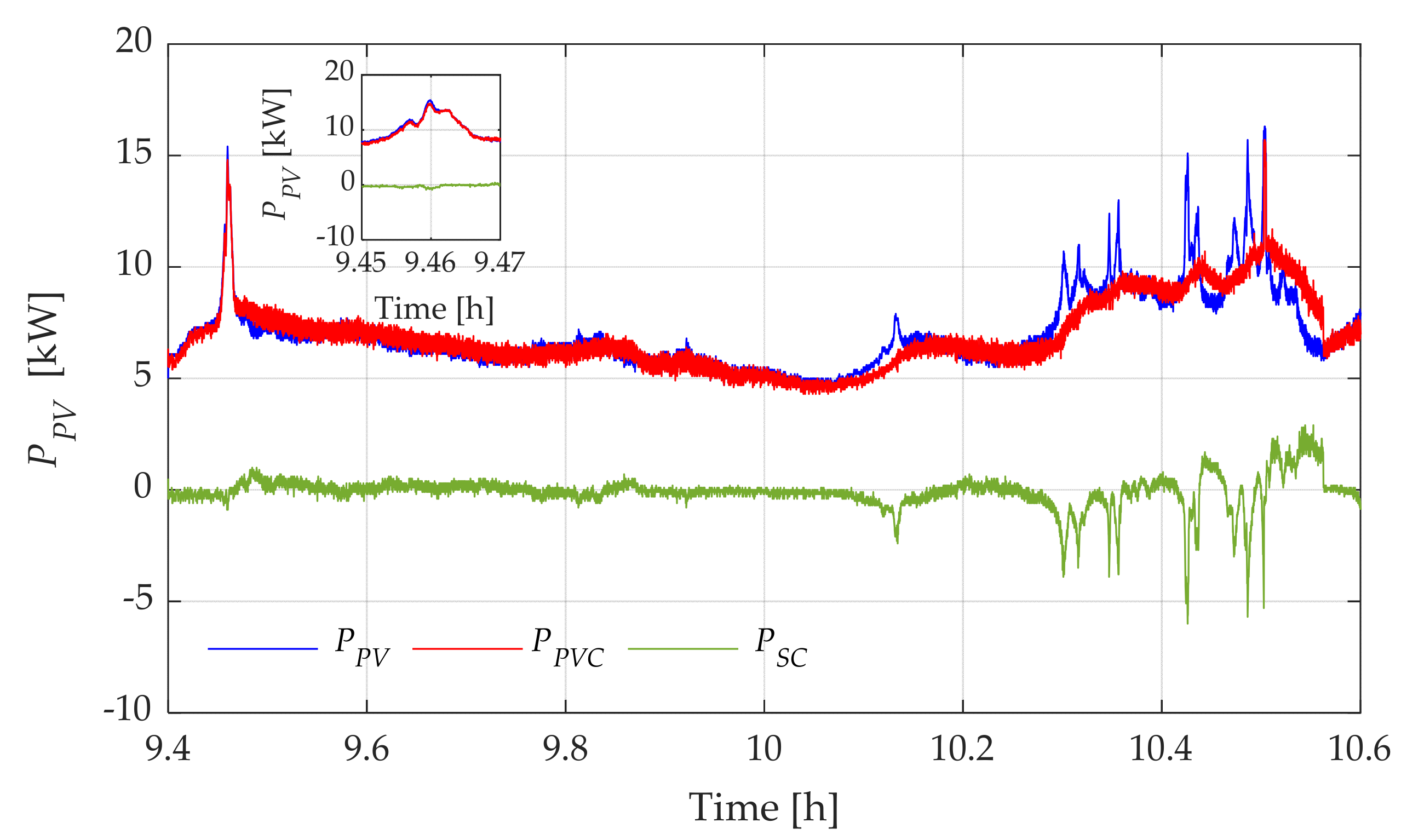

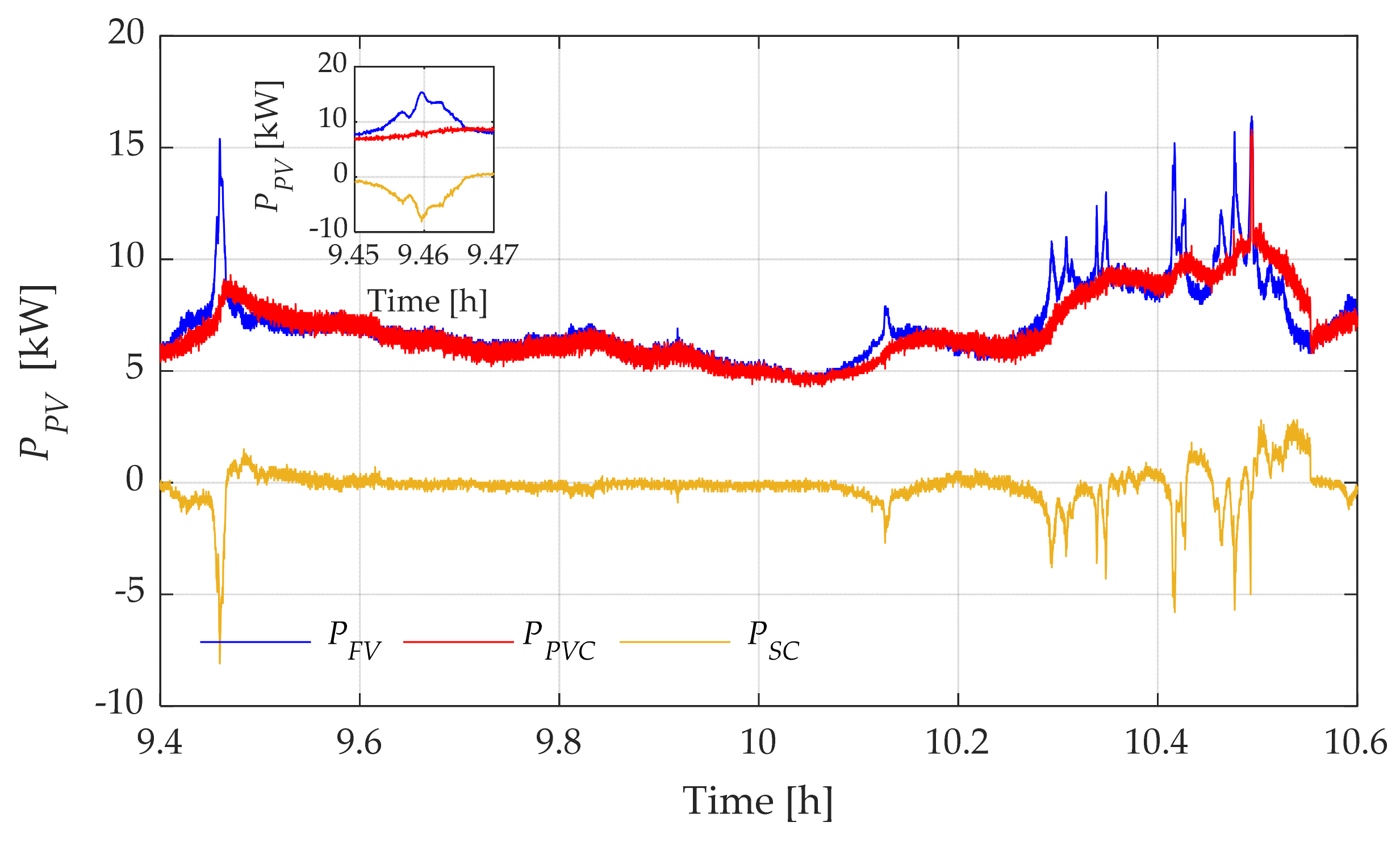

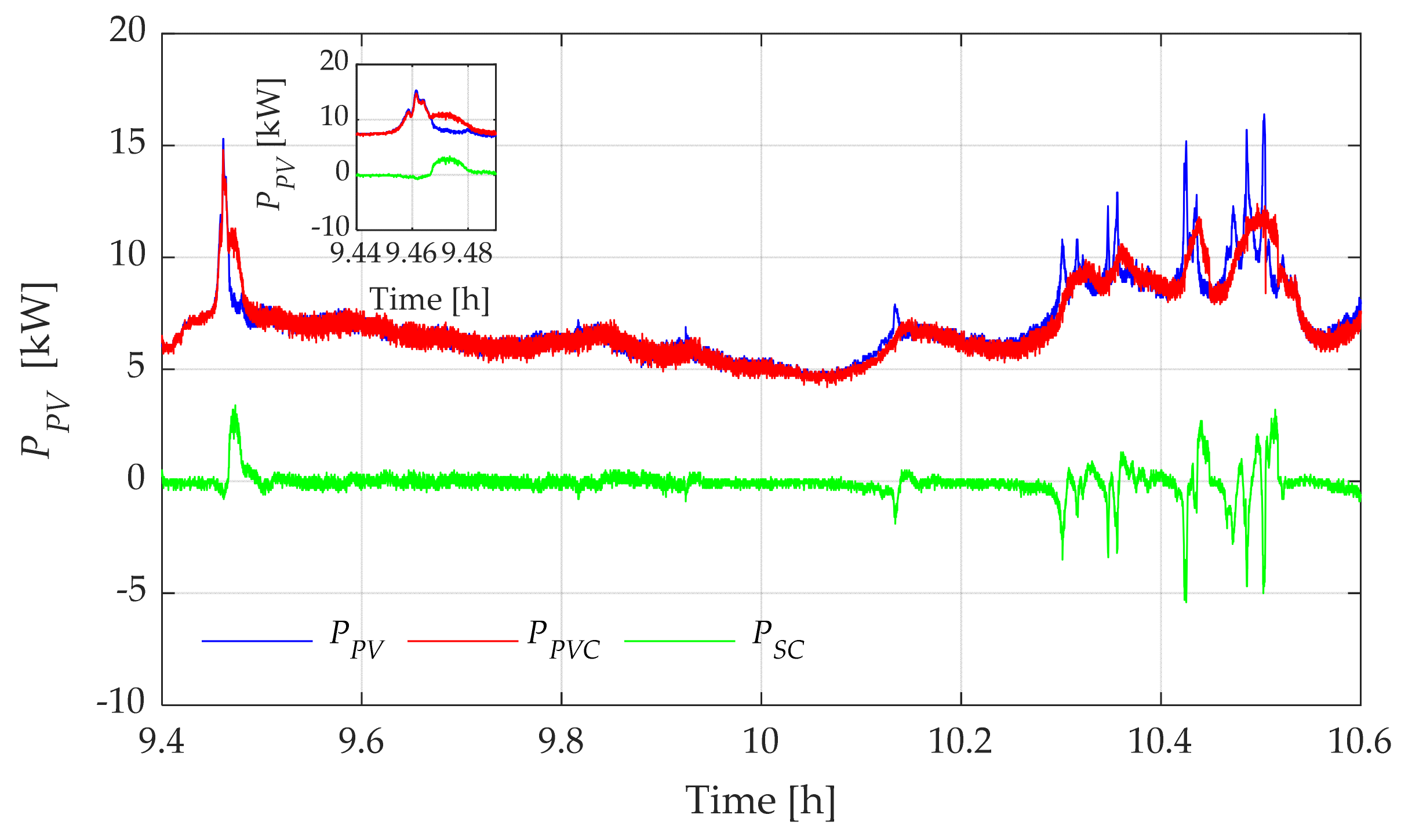

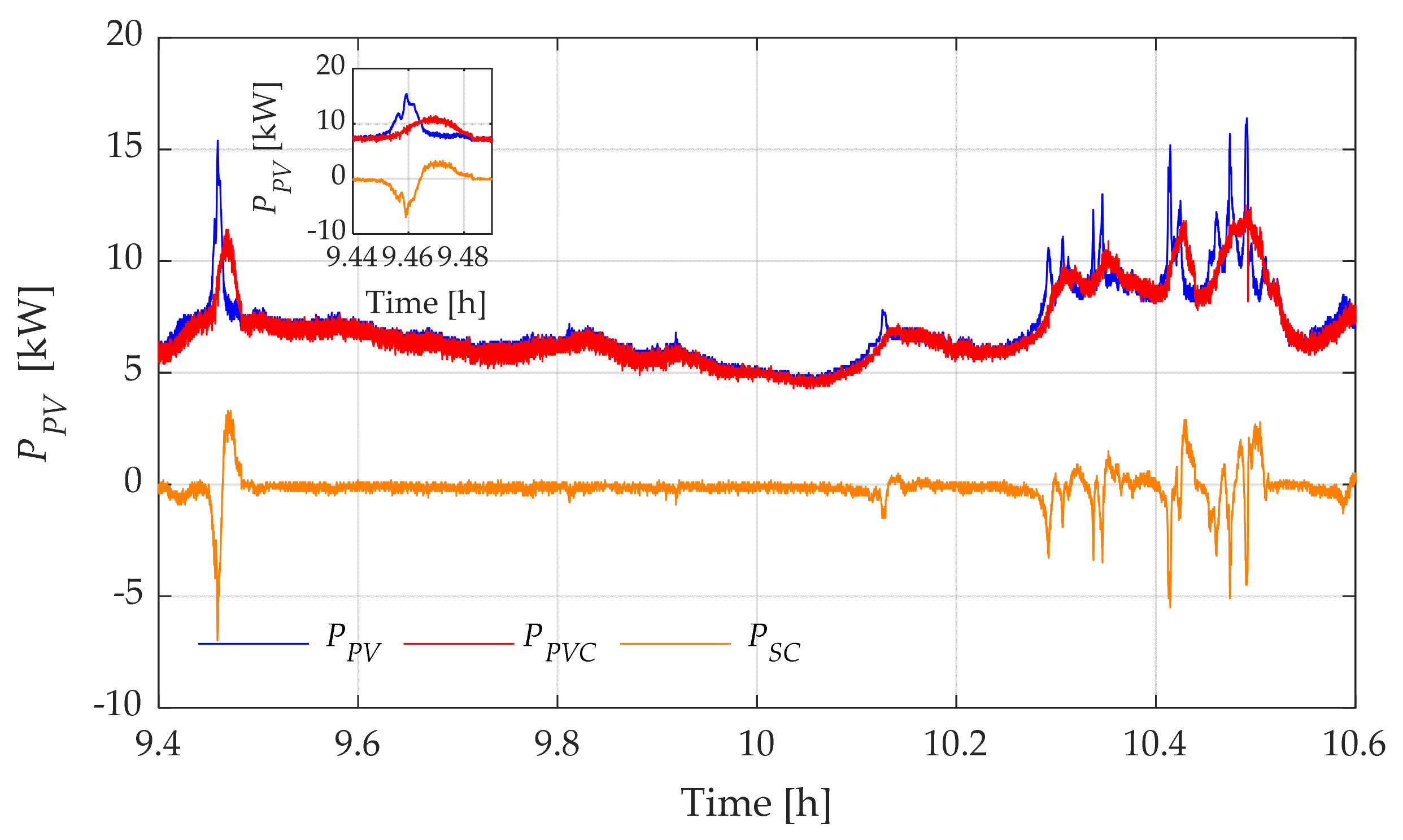


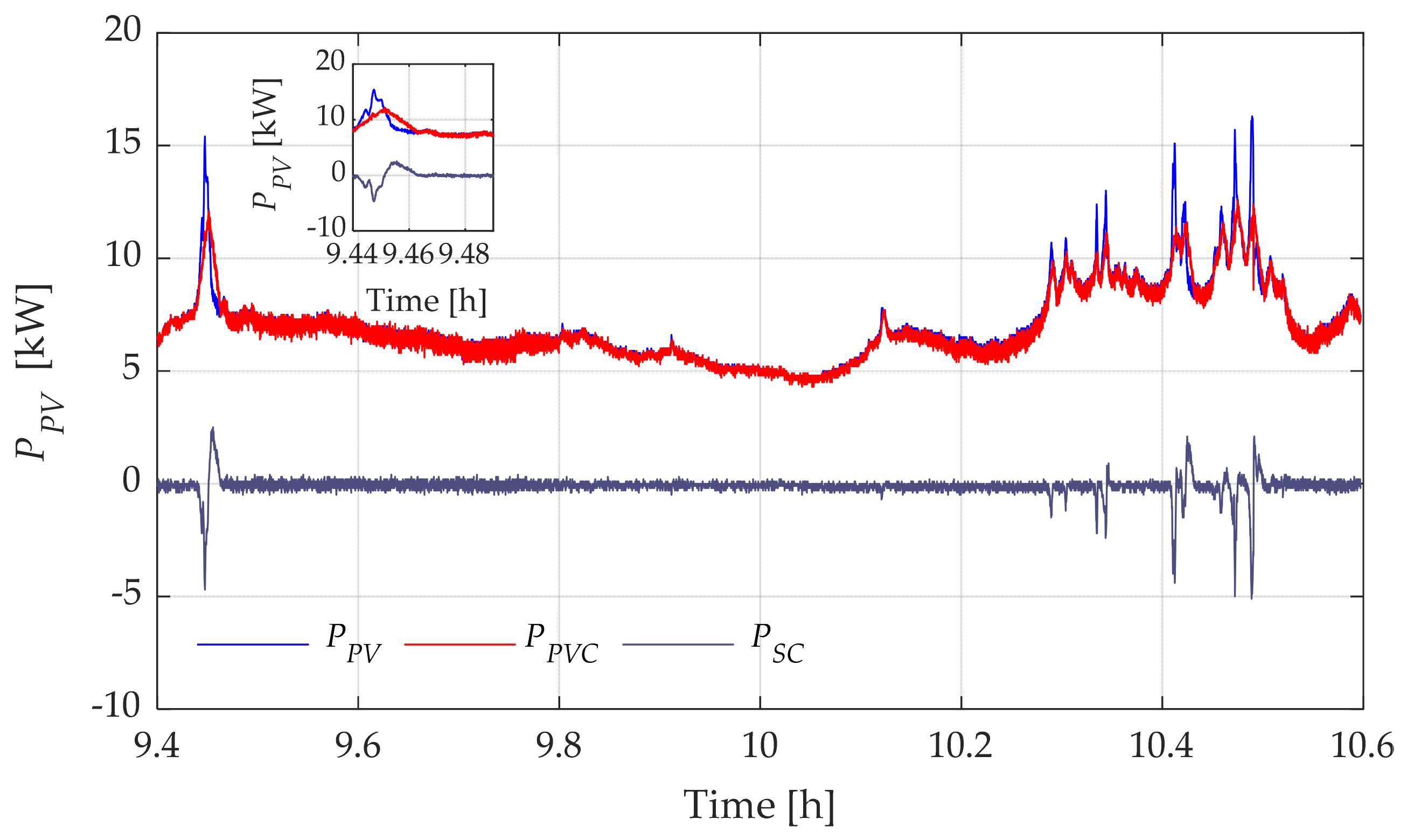


| (%) Initial | Variance without SC-ESS | Variance with SC-ESS | Variance Reduction (%) | PV Energy Delivered without SC-ESS () | Delivered Compensated PV Energy with SC-ESS () | Energy Difference () |
|---|---|---|---|---|---|---|
| 2.99 | 2.65 | 11.4 | 8.24 | 8.14 | 0.09 | |
| 2.92 | 2.56 | 12.3 | 8.42 | 8.26 | 0.15 | |
| 2.99 | 2.49 | 16.7 | 8.19 | 7.99 | 0.19 |
| (%) Initial | Variance without SC-ESS | Variance with SC-ESS | Variance Reduction (%) | PV Energy Delivered without SC-ESS () | Delivered Compensated PV Energy with SC-ESS () | Energy Difference () |
|---|---|---|---|---|---|---|
| 2.97 | 2.84 | 4.4 | 8.28 | 8.20 | 0.07 | |
| 2.98 | 2.69 | 9.7 | 8.29 | 8.16 | 0.13 | |
| 2.94 | 2.68 | 8.8 | 8.28 | 8.11 | 0.17 |
| (%) Initial | Variance without SC-ESS | Variance with SC-ESS | Variance Reduction (%) | PV Energy Delivered without SC-ESS () | Delivered Compensated PV Energy with SC-ESS () | Energy Difference () |
|---|---|---|---|---|---|---|
| 2.90 | 2.61 | 9.99 | 8.51 | 8.41 | 0.10 | |
| 2.91 | 2.50 | 14.05 | 8.43 | 8.30 | 0.13 | |
| 2.91 | 2.55 | 12.35 | 8.51 | 8.35 | 0.17 |
| Moving Average Filter | Low-Pass Filter | Rampe Rate Filter | |
|---|---|---|---|
| Advantages | Easy to implement | Preserves the characteristics of the original power signal | Smooths power variations in a controlled and gradual manner |
| Can reduce random power noise | Suppresses high-variability power noise | Avoids abrupt changes in generated power | |
| Eliminates power peaks and smooths variable power signals | Improves the quality of the power output to the grid | Improves power output stability | |
| Maintains the levels above 50% | |||
| Disadvantages | Not suitable for power signals with rapid changes | It can overly smooth the power signal in its output to the grid | Requires additional calculations to limit the rate of power change |
| Ineffective in reducing high-variability power noise | Delay in the filtered power signal | May limit responsiveness to rapid changes in generated power | |
| Prone to be affected by extreme values | Requires more complex calculations | Requires linear and simple calculations | |
| Less effective in eliminating impulsive power noise | Does not eliminate power noise; it focuses on smoothing variations | ||
| levels below 50% | at medium levels | levels below 50% |
Disclaimer/Publisher’s Note: The statements, opinions and data contained in all publications are solely those of the individual author(s) and contributor(s) and not of MDPI and/or the editor(s). MDPI and/or the editor(s) disclaim responsibility for any injury to people or property resulting from any ideas, methods, instructions or products referred to in the content. |
© 2023 by the authors. Licensee MDPI, Basel, Switzerland. This article is an open access article distributed under the terms and conditions of the Creative Commons Attribution (CC BY) license (https://creativecommons.org/licenses/by/4.0/).
Share and Cite
Villa-Ávila, E.; Arévalo, P.; Aguado, R.; Ochoa-Correa, D.; Iñiguez-Morán, V.; Jurado, F.; Tostado-Véliz, M. Enhancing Energy Power Quality in Low-Voltage Networks Integrating Renewable Energy Generation: A Case Study in a Microgrid Laboratory. Energies 2023, 16, 5386. https://doi.org/10.3390/en16145386
Villa-Ávila E, Arévalo P, Aguado R, Ochoa-Correa D, Iñiguez-Morán V, Jurado F, Tostado-Véliz M. Enhancing Energy Power Quality in Low-Voltage Networks Integrating Renewable Energy Generation: A Case Study in a Microgrid Laboratory. Energies. 2023; 16(14):5386. https://doi.org/10.3390/en16145386
Chicago/Turabian StyleVilla-Ávila, Edisson, Paul Arévalo, Roque Aguado, Danny Ochoa-Correa, Vinicio Iñiguez-Morán, Francisco Jurado, and Marcos Tostado-Véliz. 2023. "Enhancing Energy Power Quality in Low-Voltage Networks Integrating Renewable Energy Generation: A Case Study in a Microgrid Laboratory" Energies 16, no. 14: 5386. https://doi.org/10.3390/en16145386
APA StyleVilla-Ávila, E., Arévalo, P., Aguado, R., Ochoa-Correa, D., Iñiguez-Morán, V., Jurado, F., & Tostado-Véliz, M. (2023). Enhancing Energy Power Quality in Low-Voltage Networks Integrating Renewable Energy Generation: A Case Study in a Microgrid Laboratory. Energies, 16(14), 5386. https://doi.org/10.3390/en16145386












